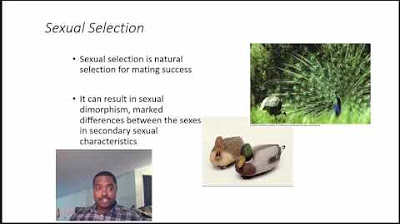Grade 11 Earth and Life Science - How Populations of Organisms Change Over Time
Summary
TLDRThis lesson explores how populations of organisms evolve over time, emphasizing the roles of genetic variation, natural selection, mutation, genetic drift, and gene flow. It discusses the principles of population genetics, explaining how allele frequencies change within populations and the significance of the Hardy-Weinberg equilibrium. Additionally, it covers the classification of organisms based on evolutionary relationships, tracing their origins and highlighting common descent. By illustrating these concepts, the video enhances understanding of evolution's mechanisms and the interconnectedness of life.
Takeaways
- 🌱 Takeaway 1: Evolution requires heritable variations, which Darwin recognized but did not fully understand due to a lack of knowledge about Mendelian genetics.
- 🔬 Takeaway 2: Alleles are variations of traits and are inherited in pairs, one from each parent, determining whether an individual is homozygous or heterozygous.
- ⏳ Takeaway 3: Microevolution occurs over short periods within populations, while macroevolution occurs over geologic time scales.
- 👥 Takeaway 4: The unit of evolution is the population, which consists of organisms of the same species living in a particular area.
- 🧬 Takeaway 5: Population genetics combines evolutionary theory and Mendelian genetics to study changes in allele frequencies.
- 📊 Takeaway 6: The gene pool includes all the genes of all members of a population, and allele frequency measures how often an allele occurs relative to others.
- ⚖️ Takeaway 7: The Hardy-Weinberg equilibrium principle states that allele frequencies remain constant in the absence of natural selection, mutation, genetic drift, and gene flow.
- 🌍 Takeaway 8: Natural selection favors alleles that confer advantages, leading to changes in allele frequency over time.
- 🔄 Takeaway 9: Mutation is the ultimate source of genetic variation, potentially producing alleles that are selected for, against, or are neutral.
- 🏷️ Takeaway 10: Modern classification systems categorize organisms based on evolutionary relationships, tracing their origins through shared characteristics.
Q & A
What is the significance of heritable variations in evolution?
-Heritable variations are essential for evolution because they provide the genetic diversity needed for natural selection to occur, enabling some traits to be favored over others in a population.
How did Mendel's laws contribute to the understanding of evolution?
-Mendel's laws of genetics, rediscovered in the early 1900s, provided a framework for understanding how traits are inherited, which was crucial for scientists to grasp the mechanisms of evolution.
What are alleles, and how do they relate to genotypes?
-Alleles are different versions of a gene. An individual inherits two alleles for each gene, leading to their genotype, which can be homozygous (same alleles) or heterozygous (different alleles).
What is the difference between microevolution and macroevolution?
-Microevolution refers to small changes in allele frequencies within a population over a short period, while macroevolution involves larger changes that occur over geologic time and can lead to the emergence of new species.
What is a gene pool?
-A gene pool is the complete set of genetic information within a population, encompassing all the alleles of all individuals in that group.
What does the Hardy-Weinberg equilibrium principle state?
-The Hardy-Weinberg equilibrium principle states that allele frequencies in a population will remain constant from generation to generation in the absence of specific evolutionary influences like natural selection, mutation, genetic drift, and gene flow.
How does natural selection affect allele frequencies?
-Natural selection increases the frequency of alleles that confer beneficial traits to individuals, while alleles associated with disadvantageous traits tend to decrease in frequency over time.
What role do mutations play in evolution?
-Mutations introduce new alleles into a population, providing genetic variation that can lead to evolutionary changes, depending on whether the new traits are beneficial, harmful, or neutral.
Can you explain genetic drift and its effects on small populations?
-Genetic drift is a random process that can cause allele frequencies to change in small populations. It may result in the bottleneck effect, where a significant reduction in population size leads to a loss of genetic diversity, or the founder effect, where a small group establishes a new population with a limited gene pool.
What is the significance of classifying organisms based on evolutionary relationships?
-Classifying organisms according to evolutionary relationships helps scientists understand the lineage and common ancestry of species, revealing insights into their evolutionary history and the development of present forms.
Outlines

Cette section est réservée aux utilisateurs payants. Améliorez votre compte pour accéder à cette section.
Améliorer maintenantMindmap

Cette section est réservée aux utilisateurs payants. Améliorez votre compte pour accéder à cette section.
Améliorer maintenantKeywords

Cette section est réservée aux utilisateurs payants. Améliorez votre compte pour accéder à cette section.
Améliorer maintenantHighlights

Cette section est réservée aux utilisateurs payants. Améliorez votre compte pour accéder à cette section.
Améliorer maintenantTranscripts

Cette section est réservée aux utilisateurs payants. Améliorez votre compte pour accéder à cette section.
Améliorer maintenantVoir Plus de Vidéos Connexes

GENERAL BIOLOGY 2, MECHANISMS THAT PRODUCE CHANGE IN POPULATIONS

Population Genetics: When Darwin Met Mendel - Crash Course Biology #18

The Evolution of Populations: Natural Selection, Genetic Drift, and Gene Flow

Population Genetics | The Evolution of Populations | Unit 4. Evolutionary Processes

Materi Biologi - 17. Teori Evolusi

Factors that Drive Evolution and Hardy-Weinberg
5.0 / 5 (0 votes)
